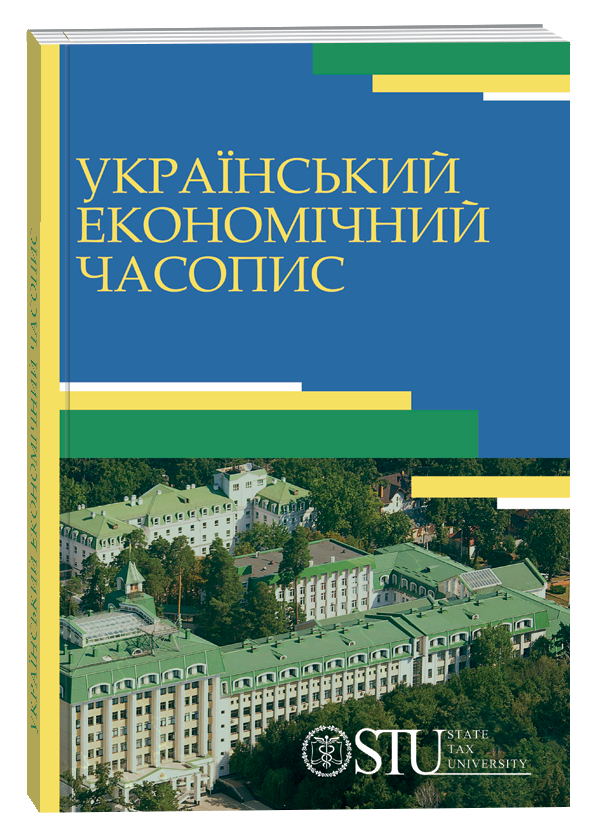DEVELOPMENT OF THE CIRCULAR ECONOMY IN THE EU: TRENDS, CHALLENGES, AND PROSPECTS
DOI:
https://doi.org/10.32782/2786-8273/2025-9-2Keywords:
green transformation, European Union, European integration, sustainable development, regulations, implementation toolsAbstract
Introduction. This article explores the development of the circular economy in the European Union as part of the broader "green" transformation of the economy. The focus is on the stages of development of the circular economy in EU countries, the tools and regulations used to promote its growth, the results achieved so far, and the goals for the future. The article examines how circular economy practices have evolved within the EU and what lessons can be drawn for other countries, including Ukraine, especially in the context of European integration. Purpose. The purpose of this research is to analyze the key phases of the circular economy’s development in the EU, identify the regulatory and institutional instruments that have supported its growth, evaluate the progress made, and outline future objectives. The study also aims to make conclusions about the European experience that could be beneficial for Ukraine as it moves toward European integration and strives to implement EU standards. Methods. The study uses a combination of qualitative and quantitative methods, including the review of EU policy documents, official reports, case studies, and academic publications. A comparative approach is used to analyze the implementation of circular economy practices in various EU member states, focusing on regulatory frameworks, financial instruments, and strategic actions. Results. The article identifies the key phases in the EU’s transition to a circular economy, from early regulatory efforts to the establishment of comprehensive frameworks such as the European Green Deal and the Circular Economy Action Plan. Several successful initiatives, such as the adoption of eco-design principles and waste management improvements, have significantly contributed to reducing resource consumption and waste generation. However, the study also highlights ongoing challenges, including regulatory fragmentation and the need for increased investment in circular technologies. The article outlines the EU’s future goals for further advancing circular economy practices, including enhancing digital solutions and fostering cross-sectoral cooperation. Conclusion. The study concludes that the EU’s experience with circular economy development provides valuable lessons for Ukraine’s future integration into the European Union. The key recommendations for Ukraine include adopting similar regulatory frameworks, investing in green technologies, and improving public and private sector collaboration. By following the EU’s approach, Ukraine can align itself with European environmental standards and contribute to a more sustainable future.
References
Горбаль Н. І., Сліпачик С. В. Циркулярна економіка: особливості та перспективи впровадження в Україні в умовах війни. Менеджмент та підприємництво в Україні: етапи становлення і проблеми розвитку. 2023. № 5 (2). С. 257–268. URL: https://sciencetst.lpnu.ua/sites/default/files/journal-paper/2024/sep/35790/240560maketmanagement-96-108.pdf (дата звернення: 15.04.2025).
Корнелюк О. А. Інноваційні бізнес-моделі та проєкти циркулярної економіки. Актуальні проблеми міжнародних відносин і регіональних досліджень: матеріали Міжнар. наук.-практ. конф. (м. Луцьк, 09 листопада 2022 р.). Луцьк, 2022. С. 125–127. URL: https://evnuir.vnu.edu.ua/bitstream/123456789/22331/1/Inov_bis_mod%209_11_2022.pdf (дата звернення: 15.04.2025)
Кузьома В. В. Інституційне середовище розвитку циркулярної економіки Європейського Союзу. Розвиток бізнесу в контексті європейської інтеграції: глобальні виклики, стратегічні пріоритети, реалії та перспективи: матеріали Міжнар. наук.-практ. конф. (м. Миколаїв, 07 червня 2024 р.). Миколаїв, 2024. С. 96–97. URL: https://repo.btu.kharkov.ua/bitstream/123456789/55961/1/konf_ROZVYTOK_BIZNESU_24-96-97.pdf (дата звернення: 15.04.2025).
Руда М. В., Яремчук Т. С., Бортнікова М. Г. Циркулярна економіка в Україні: адаптація європейського досвіду. Менеджмент та підприємництво в Україні: етапи становлення і проблеми розвитку. 2021. № 3(1). С. 212–222.
Циркулярна економіка. План дій. Circular economy. Action plan (CEAP) URL: https://www.undp.org/sites/g/files/zskgke326/files/2022-08/2%20FINAL_Tree_Circular_economy_action_plan_297x210mm_4%2B4_web_180822.pdf) (дата звернення: 15.04.2025).
Швець Н., Гораль Л., Шкварилюк М. Перехід до циркулярної економіки як передумова для розвитку «зеленої» енергетики. Scientific review. 2023. №6(91). С. 20–33. URL: https://www.naukajournal.org/index.php/naukajournal/article/view/2587/2539 (дата звернення: 15.04.2025).
Шишпанова Н.О. Розвиток циркулярної економіки регіону: досвід країн ЄС. Продовольча безпека України в умовах війни і післявоєнного відновлення: глобальні та національні виміри: матеріали Міжнар. наук.-практ. конф. (м. Миколаїв, 01–02 червня 2023 р.). Миколаїв, 2023. C. 345–347. URL: https://dspace.mnau.edu.ua/jspui/bitstream/123456789/14774/1/prod_bezp-22-05-23-345-347.pdf (дата звернення: 15.04.2025).
8 EU Regulations on Circular Economy, Sustainability and Waste that Shaped 2024. Teimas: website. URL: https://www.teimas.com/en/blog/8-eu-regulations-on-circular-economy-sustainability-and-waste-that-shaped-2024 (дата звернення: 15.04.2025).
Alonso-Almeida М., Rodríguez-Antón J. M. The Role of Institutional Engagement at the Macro Level in Pushing the Circular Economy in Spain and Its Regions. Int J Environ Res Public Health. 2020. Vol. 17. № 6. URL: https://www.mdpi.com/1660-4601/17/6/2086 (дата звернення: 15.04.2025).
Briguglio M., Llorente-González L. J., Meilak C., Pereira Á., Spiteri J., Vence X. Born or Grown: Enablers and Barriers to Circular Business in Europe. Sustainability. 2021. Vol 13. № 24. URL: https://www.mdpi.com/2071-1050/13/24/13670 (date of access: 15.04.2025).
Circular cities and regions initiative. European Commission: website. URL: https://research-andinnovation.ec.europa.eu/research-area/environment/circular-economy/circular-cities-and-regionsinitiative_en (date of access: 15.04.2025).
Communication from the Commission to the European Parliament, the Council, the European Economic and Social Committee and the Committee of the Regions: A new Circular Economy Action Plan For a cleaner and more competitive Europe. European Commission. Brussels: website. 2020. URL: https://bit.ly/3rnvl0s (date of access: 15.04.2025).
European Commission. A new Circular Economy Action Plan. For a cleaner and more competitive Europe: website. 2020. URL: https://environment.ec.europa.eu/strategy/circular-economy-action-plan_en (date of access: 15.04.2025)
Global Gateway: EU announces new EU Circular Economy Resource Centre and SWITCH to Circular Economy in East and Southern Africa programme to accelerate global transition. International Partnerships: website. 2024. URL: https://international-partnerships.ec.europa.eu/news-and-events/news/global-gateway-eu-announces-new-eu-circular-economy-resource-centre-and-switch-circular-economy-east-2024-04-16_en (date of access: 15.04.2025).
Grybaitė V., Burinskienė A. Assessment of Circular Economy Development in the EU Countries Based on SAW Method. Sustainability. 2024. № 16(21). URL: https://www.mdpi.com/2071-1050/16/21/9582 (date of access: 15.04.2025).
Mazur-Wierzbicka E. Circular economy: advancement of European Union countries. Environ Sci Eur. 2021. № 33. DOI: https://doi.org/10.1186/s12302-021-00549-0
Sanz-Torró V., Calafat-Marzal C., Guaita-Martinez J. M., Vega V. Assessment of European countries’ national circular economy policies. Journal of Environmental Management. 2025. № 373. URL: https://www.sciencedirect.com/science/article/pii/S0301479724038222 (date of access: 15.04.2025).
Horbal N. I., & Slipachyk S. V. (2023) Tsyrkuliarna ekonomika: osoblyvosti ta perspektyvy vprovadzhennia v Ukraini v umovakh viiny [Circular economy: features and prospects of implementation in Ukraine in wartime conditions]. Menedzhment ta pidpryiemnytstvo v Ukraini: etapy stanovlennia ta problemy rozvytku – Management and entrepreneurship in Ukraine: stages of formation and development problems, vol. 5 (2), pp. 257–268. Available at: https://sciencetst.lpnu.ua/sites/default/files/journal-paper/2024/sep/35790/240560maketmanagement-96-108.pdf (accessed April 15, 2025) (in Ukrainian).
Korneliuk O. A. (2022) Innovatsiini biznes-modeli ta proiekty tsyrkuliarnoi ekonomiky [Innovative business models and projects of the circular economy]. Aktualni problemy mizhnarodnykh vidnosyn i rehionalnykh doslidzhen: materialy Mizhnarodnoi naukovo-praktychnoi konferentsii (Lutsk, November 9, 2022). Lutsk, pp. 125–127 (accessed April 15, 2025) (in Ukrainian).
Kuzoma V. V. (2024) Instytutsiine seredovyshche rozvytku tsykliarnoi ekonomiky Yevropeiskoho Soiuzu [Institutional environment for the development of the circular economy of the European Union]. Rozvytok biznesu v konteksti yevropeiskoi intehratsii: hlobalni vyklyky, stratehichni priorytety, realii ta perspektyvy: materialy Mizhnar. nauk.-prakt. konf. (Mykolaiv, June 07, 2024). Mykolaiv, pp. 96–97. Available at: https://repo.btu.kharkov.ua/bitstream/123456789/55961/1/konf_ROZVYTOK_BIZNESU_24-96-97.pdf (accessed April 15, 2025) (in Ukrainian).
Ruda M. V., Yaremchuk T. S., & Bortnikova M. H. (2021) Tsyrkuliarna ekonomika v Ukraini: adaptatsiia yevropeiskoho dosvidu [Circular economy in Ukraine: adaptation of European experience]. Menedzhment ta pidpryiemnytstvo v Ukraini: etapy stanovlennia i problemy rozvytku – Management and entrepreneurship in Ukraine: stages of formation and development problems, vol. 3(1), pp. 212–222. (in Ukrainian).
Tsyrkuliarna ekonomika. Plan dii [Circular economy. Action plan (CEAP)]. Available at: https://www.undp.org/sites/g/files/zskgke326/files/2022-08/2%20FINAL_Tree_Circular_economy_action_plan_297x210mm_4%2B4_web_180822.pdf) (accessed April 15, 2025) (in Ukrainian).
Shvets N., Horal L., & Shkvariliuk M. (2023) Perekhid do tsykliarnoi ekonomiky yak peredumova dlia rozvytku «zelenoi» enerhetyky [Transition to a circular economy as a prerequisite for the development of “green” energy]. Scientific Review, vol. 6(91), pp. 20–33. Available at: https://www.naukajournal.org/index.php/naukajournal/article/view/2587/2539 (accessed April 15, 2025) (in Ukrainian).
Shyshpanova N. O. (2023) Rozvytok tsykliarnoi ekonomiky rehionu: dosvid krain YeS [Development of the circular economy in the region: the experience of EU countries]. Prodovolcha bezpeka Ukrainy v umovakh viiny i pisliavoiennoho vidnovlennia: hlobalni ta natsionalni vymiry: materialy Mizhnar. nauk.-prakt. konf. (Mykolaiv, June 1–2, 2023). Mykolaiv, pp. 345–347. Available at: https://dspace.mnau.edu.ua/jspui/bitstream/123456789/14774/1/prod_bezp-22-05-23-345-347.pdf (accessed April 15, 2025) (in Ukrainian).
8 EU Regulations on Circular Economy, Sustainability and Waste that Shaped (2024) Teimas: website. Available at: https://www.teimas.com/en/blog/8-eu-regulations-on-circular-economy-sustainability-and-waste-that-shaped-2024 (accessed April 15, 2025)
Alonso-Almeida M. M., & Rodríguez-Antón J. M. (2020) The Role of Institutional Engagement at the Macro Level in Pushing the Circular Economy in Spain and Its Regions. International Journal of Environmental Research and Public Health, vol. 17(6). Available at: https://www.mdpi.com/1660-4601/17/6/2086 (accessed Аpril 15, 2025).
Briguglio M., Llorente-González L. J., Meilak C., Pereira Á., Spiteri J., & Vence X. (2021) Born or Grown: Enablers and Barriers to Circular Business in Europe. Sustainability, vol. 13(24). Available at: https://www.mdpi.com/2071-1050/13/24/13670 (accessed April 15, 2025).
Circular Cities and Regions Initiative (2025) European Commission: website. Available at: https://research-andinnovation.ec.europa.eu/research-area/environment/circular-economy/circular-cities-and-regionsinitiative_en (accessed April 15, 2025).
Communication from the Commission to the European Parliament, the Council, the European Economic and Social Committee and the Committee of the Regions: A new Circular Economy Action Plan For a cleaner and more competitive Europe (2020) European Commission. Brussels: website. Available at: https://bit.ly/3rnvl0s (accessed April 15, 2025).
European Commission. A new Circular Economy Action Plan (2020). For a cleaner and more competitive Europe: website. Available at: https://environment.ec.europa.eu/strategy/circular-economy-action-plan_en (accessed April 15, 2025).
Global Gateway: EU announces new EU Circular Economy Resource Centre and SWITCH to Circular Economy in East and Southern Africa programme to accelerate global transition. (2024) International Partnerships: website. Available at: https://international-partnerships.ec.europa.eu/news-and-events/news/global-gateway-eu-announces-new-eu-circular-economy-resource-centre-and-switch-circular-economy-east-2024-04-16_en (accessed April 15, 2025).
Grybaitė V., & Burinskienė A. (2024) Assessment of Circular Economy Development in the EU Countries Based on SAW Method. Sustainability, vol. 16(21). Available at: https://www.mdpi.com/2071-1050/16/21/9582 (accessed April 15, 2025).
Mazur-Wierzbicka E. (2021) Circular economy: advancement of European Union countries. Environmental Sciences Europe, no. 33. Available at: https://doi.org/10.1186/s12302-021-00549-0 (accessed April 15, 2025).
Sanz-Torró V., Calafat-Marzal C., Guaita-Martinez J.M., & Vega V. (2025) Assessment of European countries’ national circular economy policies. Journal of Environmental Management, no. 373. Available at: https://www.sciencedirect.com/science/article/pii/S0301479724038222 (accessed April 15, 2025).



